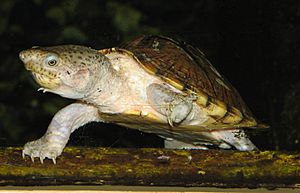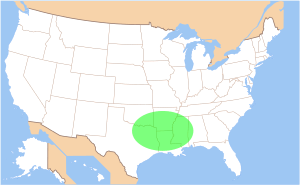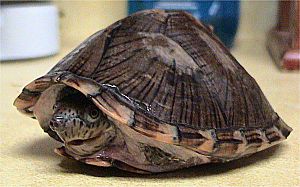Razor-backed musk turtle facts for kids
Quick facts for kids Razor-backed musk turtle |
|
|---|---|
 |
|
| Sternotherus carinatus | |
| Scientific classification | |
| Genus: |
Sternotherus
|
| Species: |
carinatus
|
 |
|
| Synonyms | |
|
|
The razor-backed musk turtle (Sternotherus carinatus) is a special type of turtle that lives in water. It belongs to a group of turtles called the Kinosternidae family. You can find these turtles living naturally in the southern parts of the United States. There are no different kinds (subspecies) of this turtle that scientists currently recognize.
Contents
Where Does This Turtle Live?
The razor-backed musk turtle makes its home in several states across the southern USA. These states include Alabama, Arkansas, Louisiana, Mississippi, Oklahoma, Florida, and Texas. They prefer warm, watery places to live.
What Does the Razor-backed Musk Turtle Look Like?
This turtle gets its name from its unique shell! Its shell, called a carapace, can grow to about 15 centimeters (6 inches) long. The shell is usually brown with black marks on the edges of each scute (the plates on the shell).
A very clear, sharp ridge runs down the middle of its shell. This ridge looks a bit like a razor's edge, which is how the turtle got its common name.
The turtle's body is typically grey-brown with black spots. Its head is often round-shaped. It has a long neck, short legs, and a sharp beak. You can often tell male turtles from females because males usually have longer tails.
The bottom part of its shell, called the plastron, is small. It has only one hinge near the front. These turtles also have small, whisker-like growths called barbels only on their chin.
How Does This Turtle Behave?
The razor-backed musk turtle spends almost all its time in the water. It loves shallow water that has lots of plants and moves slowly. You can find them in creeks, ponds, streams, and swamps.
The only time these turtles usually come out onto land is when a female needs to lay her eggs. However, both male and female turtles often come out to bask in the sun. Basking helps them warm up and stay healthy.
What Does This Turtle Eat?
The razor-backed musk turtle's diet mainly consists of small creatures that live in the water. These include freshwater clams, crayfish, snails, and various insects. They also sometimes eat fish and dead animals (carrion) they find.
Keeping Razor-backed Musk Turtles as Pets
Many people enjoy keeping the razor-backed musk turtle as a pet. They are often bred in captivity. Their relatively small size, toughness, and easy care make them a popular choice. They are often preferred over larger, more common pet turtles like the red-eared slider (Trachemys scripta elegans).
It's not fully clear how long these turtles can live as pets. Some experts believe they can live between 20 and 50 years in captivity.
See also
 In Spanish: Sternotherus carinatus para niños
In Spanish: Sternotherus carinatus para niños


